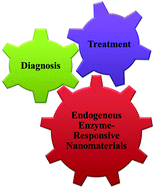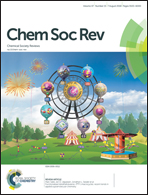Development of endogenous enzyme-responsive nanomaterials for theranostics
Abstract
The development of stimuli-responsive nanomaterials provides great potential for accurate diagnosis, effective treatment and precision theranostics. Among the sources of endogenous stimuli (e.g. enzymes, pH, redox, hypoxia, etc.) and exogenous stimuli (e.g. temperature, light, magnetic field, ultrasound, light, etc.), enzymes with intrinsic merits such as high relevance for numerous diseases, specific substrate selectivity and high catalytic efficiency have been widely employed for the design of responsive materials. The catalytic mechanisms mainly include the reduction/oxidation of substrates and the formation/cleavage of chemical bonds. So far, many enzymes such as proteases, phosphatases, kinases and oxidoreductases have been used in stimuli-responsive nanomaterials for theranostics. This tutorial review summarizes the recent progress in endogenous enzyme-responsive nanomaterials based on different building blocks such as polymers, liposomes, small organic molecules, or inorganic/organic hybrid materials; their design principles are also elaborated. In the end, the challenges and prospects of enzyme-responsive biomaterials-based theranostics are also discussed.

- This article is part of the themed collection: Probes for in vitro and in vivo fluorescence imaging


 Please wait while we load your content...
Please wait while we load your content...